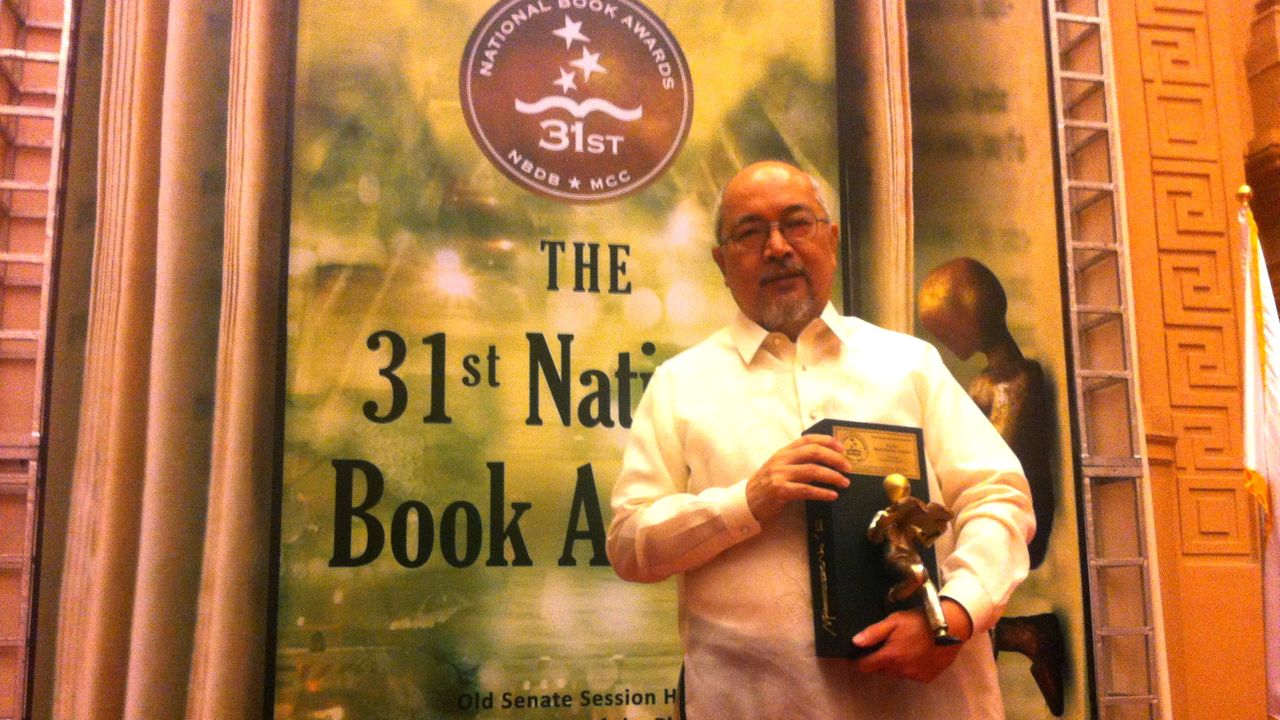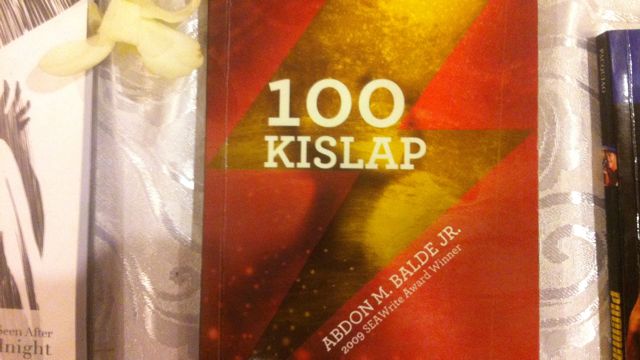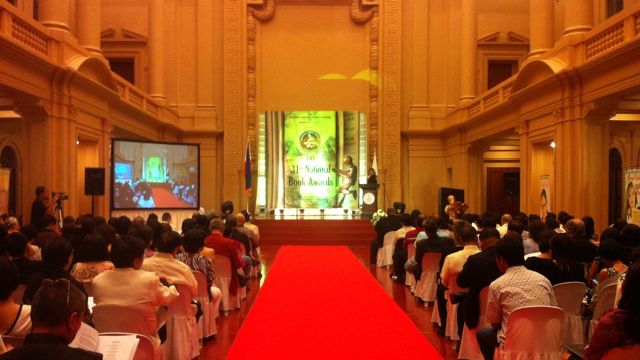SUMMARY
This is AI generated summarization, which may have errors. For context, always refer to the full article.

MANILA, Philippines – Are books also beginning to bear the imprint of the brief and fleeting flow of social media posts like Facebook statuses and Tweets?
Albay’s award-winning fiction writer Abdon M. Balde Jr. believes so, having published a compilation of 100 short stories that tackle various themes including crime, revenge, love, betrayal, myths, mysteries, humor, longing and self-identity told in not more than 150 words each.
Balde’s concise opus, 100 Kislap (Anvil Publishing Inc), won the coveted prize for short fiction in Filipino at the 31st National Book Awards held at the historic National Museum of the Philippines on November 17.
Flash fiction
In recognizing Balde’s work, the Manila Critics Circle, an elite group of literary critics and newspaper columnists that has been giving the awards since 1982, has also redefined excellence in written and published books in the country.
The award-giving body cited Balde — who has previously won National Book Awards for a novel and 2 short stories — for demonstrating extraordinary discipline in writing rather very concise short stories this time around.
“Ayaw man niyang mangyari, isunulong nya ang pagsulat ng dagli sa Pilipinas, isang tradisyon sa bungad ng ikadalawampung siglo na hindi naipagpatuloy dahil minaliit at sinikil ng mga kritikong nagnais pairalin ang uri ng maikling kwentong nililinag noon ng mga Amerikano.”
(Even if he did not want it to happen, he introduced the writing of flash fiction in the Philippines, a tradition born at the start of the 20th century which did not prosper after it was stifled by critics who wanted to maintain the kind of short fiction which Americans were developing at the time.)
The guidelines and definitions of the awards indicate that the short fiction category refers to a book of collected stories “resolved in 50,000 words each.”
Changing times
“Pinatingkad pa ni Balde sa 100 Kislap ang dagli dahil sa kanyang katangi-tanging siste at parikala. At ang ehemplo ni Balde ay patunay na hindi kailangang mahaba at nakakabagot ang panitikan,” the citation for Balde emphasized.
(Balde highlighted flash fiction even more because of his outstanding humor and irony. And Balde’s example shows that literature need not be long and dull.)
According to Balde, he wrote the flash fiction in response to the changing times and attitudes of readers.
Balde recognized that in the age of social and digital media, readers tend to have a short attention span because they multitask and are exposed to various distractions.
“Gusto nilang matapos kaagad at malaman ang istorya. Ayaw nila ng paligoy-ligoy at mahabang narrative (They want to quickly finish a book and know the story. They don’t want a long narrative.),” Balde observed.
As a result, readers prefer to read short fiction and other genres that immediately reveal the patterns of action of characters in the story.
“They want to read more. They want more variety nowadays (too). They go from action, for example, into fantasy, into science fiction. This need to read literary works in different genres leaves the writer to also experiment with different genres and forms,” Balde told Rappler.
“When you write short fiction, you go straight into the action: What is happening? There is characterization needed but mostly you go into what’s going to happen without further ado,” he further explained.
In conventional short fiction, the setting and characters of the story are first described in detail before the action is brought about.

Inevitable changes
The changes in the attitudes of readers brought about by digital and social media are inevitable, according to National Artist for Literature Bienvenido Lumbera.
“This is a new development that must be harnessed for the youth,” Lumbera told Rappler.
He recognized the potential of new media to promote knowledge and information particularly about arts and literature.
“Dapat na ang kanilang pagkalulong sa social media ay makapagbigay sa kanila ng lahat ng impormasyon at pagpapalahalaga na makukuha sa pagbabasa ng panitikan at iba pang babasahin,” Lumbera stressed.
(Being hooked on social media should provide the youth all information [they need] and help them appreciate the value of reading literature and other writings.)
Lumbera, an acclaimed poet, literary critic, librettist and activist gave the keynote address during the presentation of awards.
In keeping with technological trends, the Manila Critics Circle Special Prize for an Electronic Book was included as one of the new awards at stake this year, but none among the finalists won in the category.
Quality of content
The reading culture in the digital world must be viewed as the “end result of language as oral communication, as a way of social interaction,” according to Francis Macansantos, a writer and literature teacher.
Macansantos said that social media is going to enhance social activity since it allows more or less immediate interaction.
But the 4-time Palanca winner encouraged netizens to learn to sometimes detach from social media and spend time for reflection.
“The quality of content depends on the depth of the meditative state and experience of the writer,” Macansantos said.

75 book finalists published in 2011 competed for about 2 dozen major prizes, special awards and citations in the literary and non-literary divisions of the 31st National Book Awards.
Here is the complete list of winners:
1) Cirilo F. Bautista Prize for Short Fiction in English: Better Homes and Other Fictions: Collected Prose, by Connie J. Maraan
2) Short Fiction in Filipino: 100 Kislap, by Abdon M. Balde Jr.
3) Short Fiction in Ilokano: Karapote: Antolohia Dagiti 13 a Nasuerte A Sarita, by Ariel S. Tabag
4) Nonfiction Prose in English: Peace Warriors: On the Trail with Filipino Soldiers, by Criselda Yabes
5) Nonfiction Prose in Filipino: Almanak ng Isang Aktibista, Rolando B. Tolentino
6) Anthology in English: The Davao We Know, compiled and edited by Lolita R. Lacuesta
7) Anthology in Filipino: Telon: Mga Dula, edited by Luna Sicat-Cleto, Rolando S. Dela Cruz, Tim Dacanay, Elmar Beltran Ingles, Nicolas B. Pichay and Rene O. Villanueva
8) Anthology in Ilokano: Nabalitokan A Tawid: Antolohia Dagiti Napili A Sarita Dagiti Ilokano, edited by Juan AL. Asuncion, Joel B. Manuel and Ariel S. Tabag
9) Philippine Literary Arts Council Prize for Poetry in English: Tala Mundi: The Collected Poems of Tita Agcaoili Lacambra Ayala, edited by Ricardo M. de Ungria
10) Virgilio S. Almario Prize for Poetry in Filipino: Distungka, by Teo T. Antonio
11) Isagani R. Cruz Prize for Literary Criticism /Literary History in a Foreign Language: Dead Stars: American and Philippine Literary Perspectives on the American Colonization of the Philippines, by Jennifer M. McMahon
12) Citation: Tomas Pinpin and Tagalog Survival in Early Spanish Philippines, by Damon L. Woods
13) Isagani R. Cruz Prize for Literary Criticism/Literary History in A Philippine Language: Sawikaan 2010: Mga Salita ng Taon, edited by Roberto T. Añonuevo and Romulo P. Baquiran, Jr
14) Graphic Literature: Trese 4: Last Seen After Midnight, by Ferdinand Benedict G. Tan and Jonathan A. Baldisimo
14) Alfonso T. Ongpin Prize for Best Book on Art: The Life and Art of Lee Aguinaldo, by Ma. Victoria Herrera, Clarissa Chikiamco, Cid Reyes and Rod Paras-Perez
15) Professions: Is Franchising For You?, by Armando O. Bartolome
16) Social Sciences: Manobo Dreams in Arakan: A People’s Struggle to Keep Their Homeland, by Karl M. Gaspar
17) Citation: Lungsod Iskwater: The Evolution of Informality as A dominant Pattern in Philippine Cities, by Paulo Alcazaren, Luis Ferrer and Benvenuto Icamina
18) Science: Pinatubo: The Volcano in Our Backyard, by Robert Tantingco
19) Leisure: 100 Questions Filipino Kids Ask, Volume 2, by Alai Agadulin, Javier Asuncion, Victoria Bravo, Kata Garcia, Emylou Infante, Glenda Oris, May Tobias-Papa and Cynthia Villafranca
20) Design: Philippine Ancestral Gold, designed by Guillermo Ramos
21) Publisher of the Year: Anvil Publishing, Inc.
22) Manila Critics Circle Special Prize for a Book Published by an Independent Publisher: Si Amapola sa 65 na Kabanata, Nobela ni Ricky Lee, Philippine Writers Studio Foundation, Inc
23) Manila Critics Circle Citation for Translation: Joaquin Sy

Multi-awarded author and cultural icon Gilda Cordero Fernando was honored with the Lifetime Achievement Award for exemplifying what a publisher should be — “someone who blazes a path in intellectual history by calling attention to good research, fine writing, stimulating originality, aesthetic pleasure.” – Rappler.com
Add a comment
How does this make you feel?
There are no comments yet. Add your comment to start the conversation.